It is my belief that even birds that people consider too common, plain, drab, or boring can be photographed in ways that create visually compelling images. For instance, when I am photographing American Coots I look for colors and patterns that will compliment or be in contrast to their dark plumage. Or appealing settings, great action or an interesting pose.
American Coots are the most widely distributed members of the Rail family in North America and are very abundant in habitats with open water. Some bird photographers pass up on photographing American Coots because they aren’t colorful and are common but if you have been following my blog for any length of time you know that if it has feathers and it is a bird, I’ll photograph it.
These members of the Rail family have large, lobed greenish feet, red eyes, very dark bodies with ivory colored bills topped by a reddish shield. They are often in the presence of ducks and are at times they are mistakenly labeled a “duck” by people not familiar with birds. Coots can make a lot of noise and while they are gregarious they will often chase each other around in displays of aggression which is great fun to watch and photograph.
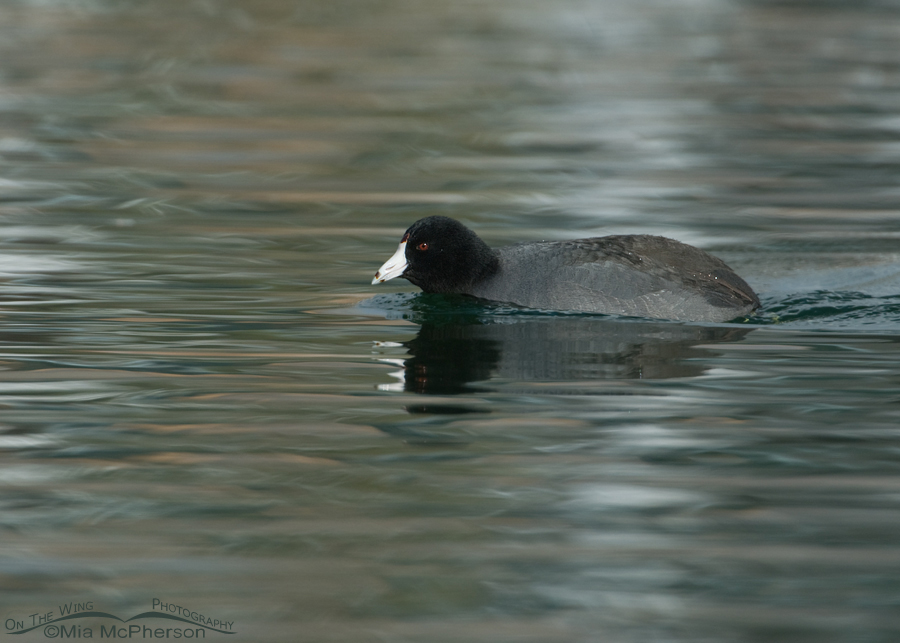 American Coot small in the frame – Nikon D200, tripod mounted, f7.1, 1/800, ISO 320, Nikkor 200-400mm VR with 1.4x TC at 400mm, natural light
American Coot small in the frame – Nikon D200, tripod mounted, f7.1, 1/800, ISO 320, Nikkor 200-400mm VR with 1.4x TC at 400mm, natural light
American Coots are difficult to expose correctly because of their very dark bodies and their very white bills, it can be a challenge to get details in the black without blowing out the whites in the bill. Paying attention to the angle of light and deciding whether to use negative or positive exposure compensation is critical when considering what settings to use when photographing these birds.
I photographed the American Coot in the image above on a very chilly winter day at a pond near where I live. The shades of white in the water were caused by snow on the bank of the pond and the golden tones were from the colors of the dried cattails along the shore. I decided to compose this image with the American Coot small in the frame because I felt the water was dramatic and was as visually stimulating as the bird itself.
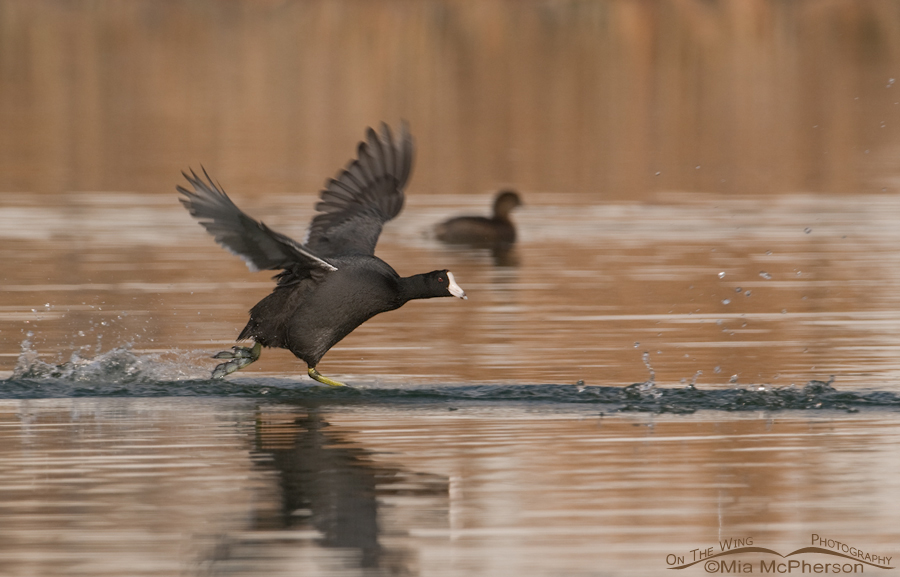 American Coot chasing another Coot – Nikon D200, tripod mounted, f7.1, 1/1000, ISO 250, Nikkor 200-400mm VR with 1.4x TC at 300mm, natural light
American Coot chasing another Coot – Nikon D200, tripod mounted, f7.1, 1/1000, ISO 250, Nikkor 200-400mm VR with 1.4x TC at 300mm, natural light
Earlier I mentioned that I look for great action when photographing American Coots, I feel that the action can convey not only a sense of movement but lends a bit of excitement too.
When I photographed the bird in this image I had been concentrating on bird that were close to where I was sitting with my tripod in front of me when I heard the Coots making sounds that indicate a squabble might happen soon so I zoomed back and got prepared for some action. I saw one of the birds sneaking up on another and when the lead bird took off running across the top of the water I started tracking the bird that was doing the chasing and created a series of images of this Coot “walking on water”. Make that “running”. I didn’t even mind the out of focus Pied-billed Grebe in the frame because it was so out of focus and not intersecting with the main subject plus I also liked the feeling of depth the Pied-billed Grebe added to the image.
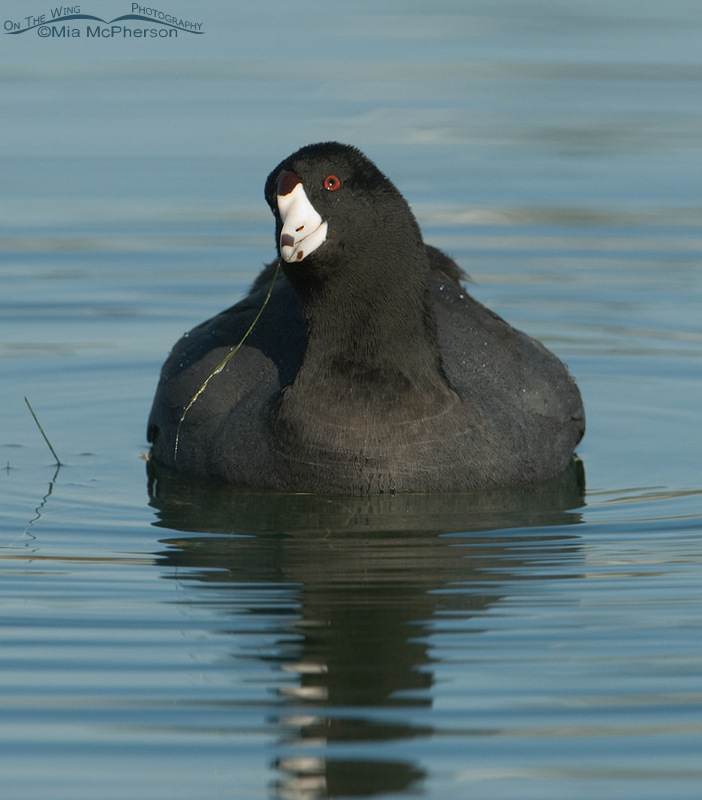 American Coot with tilted head – Nikon D200, tripod mounted, f9, 1/320, ISO 320, Nikkor 200-400mm VR with 1.4x TC 315 mm, natural light
American Coot with tilted head – Nikon D200, tripod mounted, f9, 1/320, ISO 320, Nikkor 200-400mm VR with 1.4x TC 315 mm, natural light
I also mentioned that I look for interesting poses when photographing Coots and sometimes that includes the head angle of the subject. I know some pro photographers would “wish” that the bird’s head in the frame above was tilted a few degrees downward and to the left side of the frame to convey better direct eye contact between the subject and viewer. I sort of think that is splitting feathers and I simply do not feel that I “must” always have the subject looking directly at me.
I can clearly see the eye here and because the bird is looking up I can imagine it was looking at something in the sky. For me that adds interest and doesn’t subtract from the overall appeal of the image.
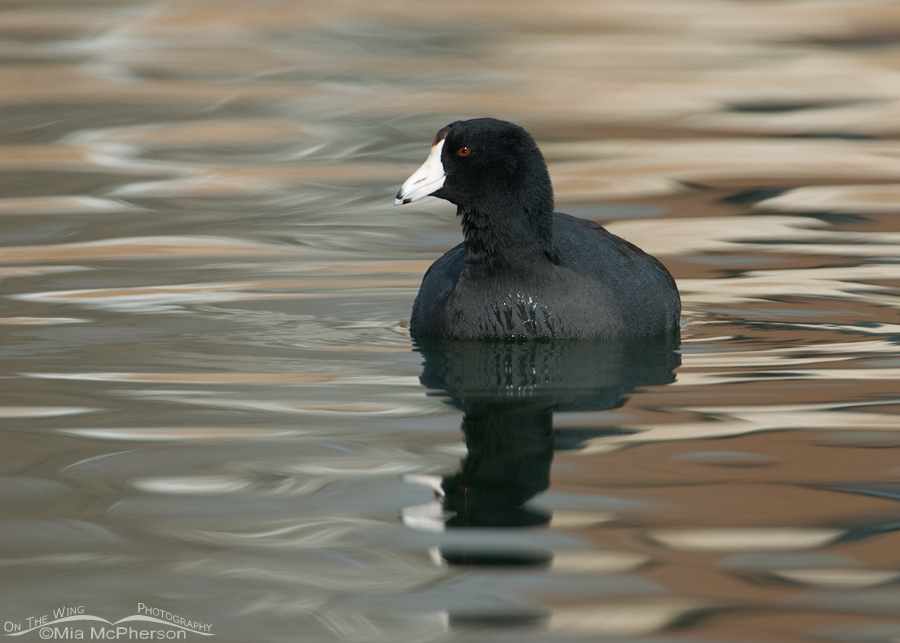 American Coot in silky waters – Nikon D200, tripod mounted, f7.1, 1/500, ISO 250, Nikkor 200-400mm VR with 1.4x TC at 400mm, natural light
American Coot in silky waters – Nikon D200, tripod mounted, f7.1, 1/500, ISO 250, Nikkor 200-400mm VR with 1.4x TC at 400mm, natural light
Some of the features I like most about the image above is the silkiness of the water, the profile view of the head of the bird and how the ripples in the water distorted the reflections of the snow and vegetation to create a wonderful contrast from the plain colored bird not only in the colors but in textures and swirly patterns.
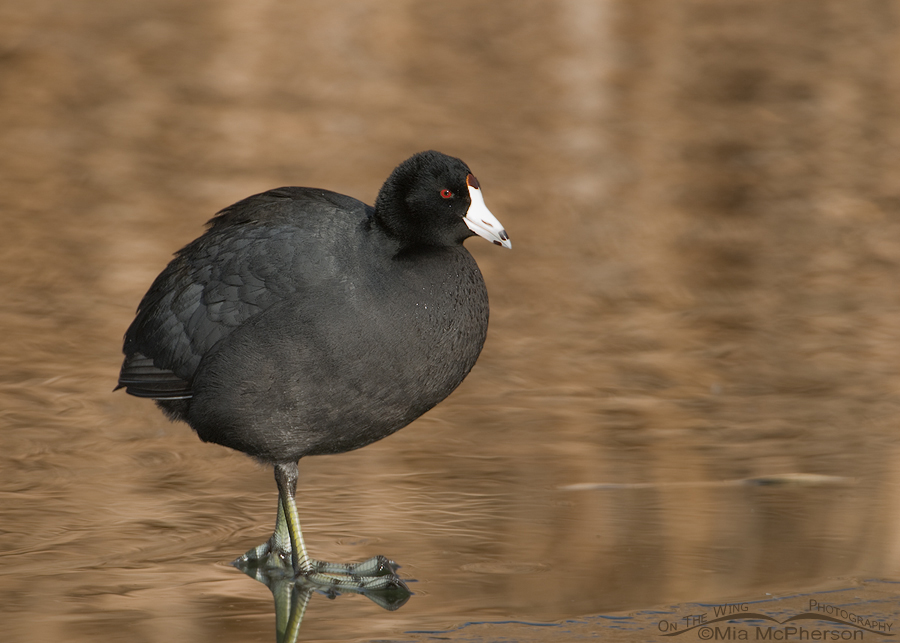 American Coot standing on bronze colored ice and water – Nikon D200, tripod mounted, f7.1, 1/350, ISO 250, Nikkor 200-400mm VR with 1.4x TC at 400mm, natural light
American Coot standing on bronze colored ice and water – Nikon D200, tripod mounted, f7.1, 1/350, ISO 250, Nikkor 200-400mm VR with 1.4x TC at 400mm, natural light
This American Coot was standing on thin ice near the shoreline and just the mere weight of the bird pushed the ice slightly under the water, just enough that the stand of cattails was reflected on all of the water’s surface visible in this frame. Because the warm bronzy tones of the water are in contrast with the dark plumage of the bird the Coot stands out very well from the setting.
Even “Plain Jane” birds can sparkle in the right light, setting or pose. Don’t you agree?
Life is good.
Mia
Click here to view more of my American Coot photos plus facts and information about this species.


love your photos, especially the quality of the light on the water.
Thanks Scott, the light can be very lovely at the pond where I took these images.
Mia, once again I don’t have enough superlatives for these photos. The image of the Coot pattering across the water is a perfect action shot of this species. It is funny that you mentioned the Pied-billed Grebe in the background. When I first looked at the photo, I saw the Coot’s back foot in stop motion and the splash they typically make and flashed back to my experiences watching American Coots running on water in large flocks and the sound they make. I never noticed the grebe!
The most splendid shot of the Coot with its head tilt is my favorite. You have caught that creamy white beak perfectly and it looks to me like it is looking skyward for predators. The following shot with the silky water is simply dreamy.
Larry,
I’m glad the action shot of the Coot brought back your experiences with Coots fighting, they are such fun to watch then. I really like the tilted head shot too because it make me wonder “what is up there”.
Thanks for your wonderful comments on these images.
I do agree. Coots are marvelous little birds. They’ve got attitude and there’s plenty to enjoy. I think your shots are excellent. In addition to the high general quality of the images, you captured their attitude very well.
When you said, “If it has feathers and it is a bird, I’ll photograph it,” it left me wondering what other feathered things there are? If I came across a non-bird with feathers, I’d probably have to take a picture of that : )
Thanks for sharing.
Laurence, Coots do have neat attitudes. Thanks for your wonderful comment on these images.
I was thinking about people who wear feathers in thier hair, have feather earrings or boas, that is why I added the “and it is a bird”. I’m not too keen on photographing those!
Wonderful images Mia. You captured their colors very well, Love the lopsided look face on.
Dan, I like the lopsided head image too, they are neat birds. Thanks for your comment.
Wow!
You made the coots beautiful!
Love the pics!!
Thank so much Judy, they are beautiful, interesting birds!
P.S. I love the title you gave this post. I love catchy titles. And, yes, shooting RAW is amazing. I am sorry that I held out so long. I was just afraid that this old dog couldn’t learn new tricks, but I am surprising myself.
Bob, glad you like the title of this post, it just seemed to fit well. You aren’t an old dog and you are doing great with your RAW conversions!
First I must say that you done a wonderful job on the exposures of these coots. You simply nailed them. You may remember, I did a post several weeks ago on the subject of these birds. I had the same problems you did, but you have done a much better job of solving than I did. But our methods are similar. Especially what you said about the eyes. My only requirement, of course is to have the eyes in focus. I don’t care much where the bird is looking. And, my feeling is the same, if it is a bird, I want to photograph it. There is a certain beauty in each and every specie.
P.S. You didn’t mention but did you adjust your EV on any of the exposures?
Hi Bob,
In answer to your question, I didn’t have to adjust my exposure for any of the images on this post, I was fortunate to have the sun behind my back when I took the photos so the blacks were well exposed, on three of the images I did tone down the whites of the bill slightly in ACR. Shooting in RAW is awesome!
I do remember your post on Coots (they were beautiful) and am glad we agree on “if it is a bird, I want to photograph it“!
Coots are awesome birds and challenging to photograph and I love a challenge!
Mia, this is SUCH a cool post! The underrated coots, if you ask me. I remember the first time I saw one of those knock-down, drag-out fights between two coots. I got one barely adequate photo of it because I didn’t have my camera settings right. And ever since, I’ve been waiting to have a close enough encounter with another such incident. Hasn’t happened. I admire your love for the coot action shot. I totally get it!
Ingrid, I’m tickled that you get why I feel like I do about the Coot action shot. They are moving so fast when that chase action happens that it is hard to get the shots if there isn’t enough shutterspeed plus they can be difficult to track. I agree, Coots are underrated. I hope you get your Coot fight shots soon! Thanks much for your comment.
Mia, these American Coot images are wonderful! I really enjoyed reading your thoughts on photographing these cool looking birds.
Thank you Julie, I think Coots are beautiful, I’m a sucker for all birds!Thanks for your wonderful comment.